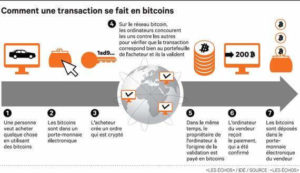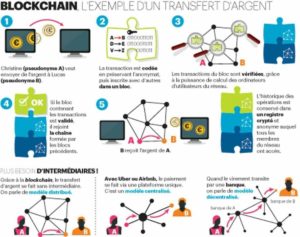
Have you ever dreamt as a customer to be able to burn credits from your loyalty programs within a large network of companies? or to be sure to read valid reviews about your future travel?
As a stakeholder in the travel industry would you be interested in securing all your booking transactions? And what about refunding automatically and instantly your customer if an issue arrises?
It would be nice, wouldn’t it? a little bit like flying on time, or accessing some Wifi on trains!
These examples and a lot of other possibility are achievable today with what is called BLOCKCHAIN.
Yes I know, this word is pretty trendy nowadays … it’s about virtual currency, bitcoin, cryptocurrency together with more unknown words like hashing, asymmetric key, encryption, mutual consensus and a few others.
The blockchain process is mainly used to provide secured financial transactions. Although travel agencies don’t have exactly the same kinds of activities as banks, blockchain can provide very relevant solutions to some big issues that the travel industry faces.
Let’s try to understand.
Here is a first definition to try to easily explain the blockchain process :
Blockchain was born in 2008, through the virtual currency called bitcoin. It was supposedly created by Satoshi Nakamoto, “somebody” who has never been met by anybody and could even be an avatar.
According to Wikipedia blockchain is an open distributed database, that can record transactions between two parties efficiently and in a verifiable and permanent way. One of the key aspects is that there is no need for any intermediary.
If, like me, things are not 100% clear, here is my personal definition :
It’s a large network of independent participants who collaborate to enable verified transactions between each other with a virtual currency.

The most famous virtual currency used is Bitcoin, but some others exist for example the Ethereum or Ripple.
The main benefit of blockchain is the fact that it is not controlled by any higher entity like a bank, an authority or a company which would centralize all transactions. Transactions, in the blockchain process were designed to decentralise and avoid the need for a trusted third party. And on top of that transactions are distributed.
It is quite similar to the way we were exchanging files a few years ago when we were downloading using Kaza or eMule : a peer to peer network.
Within the Blockchain process each participant has in their computer some “software” which is able to connect and retrieve data from other participants
Therefore the blockchain process allows people who do not know each other (and therefore wouldn’t normally trust each other) to perform secure transactions through the trusted network built by the blockchain without needing a third party.
Check out the following illustrations for visual look.

Blockchain was created during an unstable economic period. The Idea was to create a virtual currency : Bitcoin with the objective to eventually replace cash and become the most famous virtual currency.
But to reach this goal, Bitcoin had to solve 3 problematics situations :
- How can the currency be exchanged between users?
- Bitcoin should be used only once.
- How to gatanti value of the money without validation from a higher authority.
The following solutions were put in place
- Peer to peer exchanges similar to downloading files.
- All transactions are recorded and can be used to verify that no new bitcoin have been created.
- All uses can invalidate the transactions and can be verified by all bitcoin users.
In 2012 after several years of existence we were able to say
- Peer to peer exchanges correspond to disintermediation.
- The recording transaction avoid any problems of traceability
- The ability to verify and keep the transaction records have led to distributed consensus ie: No central authority is involved.
Blockchain is very secure and the data can neither be falsified nor deleted .
How did blockchain become so secure?
Blockchain is so powerful because it is unforgeable and inviolable. In fact the algorithmes secure the network.
The network uses two techniques : Hashing and encryption.
- The hashing provide security and consistency.
This mathematical function generates a random sequence of numbers or letters from any digital data : The hash. It’s a unique code similar to a fingerprint. The hash makes it impossible to reconstitute the initial data and to go back to the original data because it’s too complex.
- Encryption guarantees the signature and the origin about blockchain.
Encryption is performed using asymmetric keys : a private and a public one are linked together.
The private key can only be used by the user and initiate the transaction.
The public key is shared, it serves as the address and designates the recipient.
In an attempt to summarize:
When someone wants to make a transaction in Bitcoin, they post it on the web :
This information is automatically transformed into a unique code : the hash
The hash is validated by the « community » after verification of the previous transactions. The signature and asymmetric key are used to verify that the user indeed has virtual money in their possession.
The hash is added to all other codes generated by all the network users up until then. this creates a code that is registered on all the servers in the network, and which will also be used to code new transactions.
With a schema it may be a little clearer:


This process leads to in a decentralized system. The data is not stored on a single server, but on all computers in the blockchain. The information is distributed over the entire network and the process removes all intermediaries, we are talking about disintermediation.
Once have understood this process we would now like to fully understand howt this can be useful because our system certainly has flaws in it but it does work.
For a great number of applications, three mains points can explain the interest of the Blockchain:
- Disintermediation in order to reduce costs
- Traceability as a digital proof of existence
- The distributed consensus that facilitates uses working together, the security and the infringement of existing evidence.
That’s why the blockchain concerns all services that need to never be challenged, which can be ceded and then take on value.
We find this use in exchanges of securities, votes with the development of e-politics and e-democracy for example but also in the banking sector.
Interbank exchanges are made more quickly and securely without having to go through a third party, while being able to verify that the different protagonists are solvent because the system is public and distributed.
Blockchain can be used in different situation to avoid falsification of official documents including :
- University degree
- Land registry
- Food traceability (china that already uses it)
Now that we have understood the interest of the blockchain and its sectors of predilection, what about the tourism sector ?
What are the opportunities in tourism?
The explanations of this process were certainly a little long but necessary to imagine and understand the usefulness of the blockchain in the tourism sector.
Mr Jean Luc Bogros of Winn, who spoke at the event « Future Of Business Travel 2017 » # FBT17 talked about « incredible things » with the main subjects around loyalty points, reviews of chaining information or other …
We will try to understand the main applications he referred to
Management of loyalty programs:
Currently loyalty program not used very often by customers because they are very restrictive. Companies find them to manage both in accounting and CRM. These loyalty programs are shunned and represent a real source of consumer dissatisfaction.
Thanks to the blockchain, it will be possible to simplify and secure the exchanges: it will enable a pairing (or an exchange of information between computer system) between loyalty points and a currency, which can be virtual. Points generated in one company would be worth a certain number of points in another company.
It would be like a marketplace where the points of two companies could be compensated with the notion of blockchain.
As for the travel professional, they will have a record of this transaction and will be able to extend his network of partners, without any restrictions, and thus have a simple, effective solution to offer their customers.
Multi-operator transaction management:
Just as it is able to manage multi-operator transactions without necessarily being financial, it is easy to imagine that the blockchain can manage reservations between different carriers or providers.
The blockchain could allow travel agencies to publish multi-operator international « tickets » with various commercial policies, these « signature » would be verifiable by all partners of the chain and thus security and transparency could reassure the customer.
The virtual currency would not be necessary at the time of the exchange, but could be replaced by a « token » system that would contain all the blockchain information referring to this transaction, since the signatures are secure and tamper-proof, and the transactions verified.
This concept has already been set up by the IATA Clearinghouse for payment but that could be extended to other providers than airlines and would make it possible to secure the information and to ensure the services ordered in addition to the payment.
Customer Reliability Management:
How many of us have ever wondered about the veracity of a posted opinion about accommodation or other benefits? We have more and more doubts about the authenticity of what we are reading.
The blockchain, certifies the customer’s comment, either by a process of certification of the opinion, or by a process of the traceability of the editor.
Two start-ups are currently developing these systems:
Buuyers.com which previously was a site of opinion of professionals has developped its technology by integrating the blockchain in its development in order to secure the opinion before registering it:

The World Table that automatically moderates malicious notices or trolls is working on verifying to the authenticity of the « editors » of opinion.
Reliability management of on-line reservations:
The blockchain will become indispensable to ensure the reliability of online reservations, indeed, we realize that 5% to 10% of bookings are made with errors, mainly errors of payment or fraud.
A good way to lower this rate is to use the blockchain, because with its notions of distributed consensus process and disintermediation, the payment for the professional as well as the benefit purchased by the customer will be secured.
Webjet Australian online travel agency, allied with Microsoft to create a Blockchain solution “Proof of Concept” that is a way for companies to find a solution to the problem. Transactions will be instantaneously verified to streamline procedure to save money and reduce the risk of fraud
Management of identity and administrative documents:
During the journey the blockchain facilitate the management of administrative identities by speeding up the procedure of going to customs.
The principle could be to reference all our administrative documents: passport, photos, fingerprint in the blockchain. Then, with a token containing all this information, administrations could easily find the identity information they need when entering customs, for example.
Companies that are working on biometric recognition like Thales are already working on this.
Management of insurance company contracts:
Management of insurance, cancellation, delay etc. could be managed in the same way. Thanks to the smart contract, the terms of which would be stipulated in the blockchain, insurance companies could automatically trigger a payment or compensation if they have knowledge of the damage suffered by customers. In this case, the blockchain would give the confidence to automate the declarative phases, without resorting to a third party.
So convinced by the process of the blockchain?
In fact, this system is still used very little, but the number of registered users is increasing more and more and have reached more than 10 million.
Even if it is still in the financial world that the use is the widest with the system of crypto-currency, the applications in the environment of the tourism are alluring.
From the point of view of the traveler, there is the security of information, services and exchanges that could be increased.
From the professionals’ point of view, these applications represent a saving of time, thus saving money in the management of their files, securing bookings, and information relating to customers and services exchanged.
We are therefore on a winning winning collaborative and trustworthy exchange.

Comments (0)